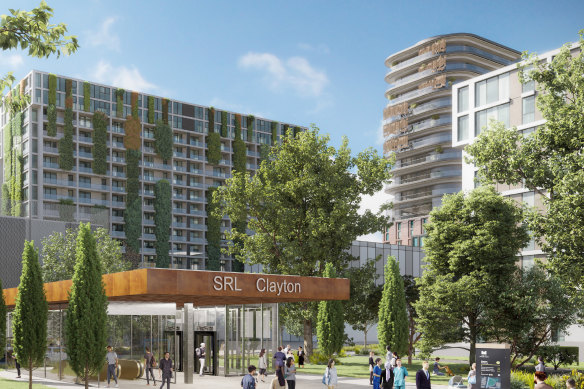This was published 1 year ago
This suburb has the potential to be Melbourne’s second CBD. But there’s one shortcoming
A planning overhaul of Clayton centred around two new Suburban Rail Loop (SRL) stations may not be enough to turn the burgeoning suburb into a second CBD for greater Melbourne.
The Allan government’s $34.5 billion underground rail line and urban redevelopment project aims to make Clayton and the nearby Monash University precinct into a jobs hub for 219,500 people by 2056 – almost as many as those working Melbourne’s CBD today.

The next SRL stop south of Clayton is at Cheltenham, 7.5 kilometres away.
Andrew Butt, professor of urban planning at RMIT University, said decentralising Melbourne was imperative for its future and Clayton was an ideal place for a second CBD.
However, he said two new rail stations would not be enough to underpin that level of development and employment, considering Melbourne’s CBD has five train stations and an extensive tram network.
“It’s too concentrated and delivers the benefits to too small an area,” Butt said. “Where’s the opportunity to develop Clayton South, where the route passes through, or sites on the east side of Moorabbin?”
SRL East has six stations along its 26-kilometre length between Cheltenham and Box Hill, or one every 4.3 kilometres on average, which is sparse compared to many modern subway projects. The Sydney Metro Northwest has 13 stations over 36 kilometres, or one every 2.7 kilometres.
The next SRL stop south of Clayton is at Cheltenham, 7.5 kilometres away.
Butt said building so few stations so far apart would result in an outcome similar to Box Hill today: an outcrop of high-rise buildings surrounded by an expanse of low-density suburbia.
“It’s a really lost opportunity,” he said. “If we wanted to create a decentralised city at higher density – not simply a city of the same density we have now, with high-rise towers sticking out of it at Clayton and Monash Uni – we need to invest in improving transport all the way along [the tunnel],” he said.
The growing research cluster around Monash University is already the biggest employment centre outside central Melbourne and has been considered prime for further development as a high-skilled jobs hub.
The SRL business case says the line will help grow the number of jobs at Monash from 36,500 in 2018 to 162,000 in 2056, and more than double employment at nearby Clayton from 21,000 jobs to 57,500.
City of Monash mayor Nicky Luo said there was significant investment driving the Monash research and technology cluster, which now includes the CSIRO, the new Victorian Heart Hospital, Monash Health, biotech company Moderna, Telstra and the Australian Synchrotron.
“The Suburban Rail Loop will better connect this exciting area with the rest of Melbourne,” she said.
However, Luo said the council has reservations about the planning process and that it was vital plans for the precinct focus development and density in appropriate areas.
The SRL Authority has taken planning controls over large areas around each new station at Cheltenham, Clayton, Monash University, Glen Waverley, Burwood and Box Hill, and flagged high-rise development close to each station.
SGS Economics and Planning partner Marcus Spiller said pulling jobs out of the CBD and into new hubs would pay strong economic and social dividends.
“The key ingredient for a modern employment hub is having access to a skilled labour force, and this is probably the jewel in the crown for Monash/Clayton,” he said.
“The SRL will improve its ability to capture skilled labour, which will make it an even more favourable location.”
Spiller said rezoning was the first and easiest step in making the new precincts work.
“There needs to be positive government action to make these employment hubs happen. The private sector will come to the party, but only if the infrastructure is available and public transport is available.”
On December 7, SRL Minister Danny Pearson designated large districts around each station as SRL planning areas, giving the SRL Authority planning powers – including the ability to rezone to allow higher apartment and commercial buildings.
The Clayton and Monash precincts were combined as one massive area stretching five kilometres from the Monash Freeway in Mount Waverley to Kallay Street in Clayton South, and from Huntingdale Station in Oakleigh South to Springvale Road in Mulgrave.
The SRL East stations at Cheltenham, Clayton, Glen Waverley and Box Hill are located near existing above-ground train stations, while Monash and Burwood will be connected to the rail network for the first time.
SRL East is set to open in 2035. It is envisaged as the first stage of a 90-kilometre circular rail line that will continue through the northern suburbs to Melbourne Airport and then further west to Werribee. However, the state government has not committed to those future stages.
A Victorian government spokesperson said the areas around Monash and Clayton stations will “continue to grow to become Melbourne’s epicentre for innovation in health, medicine, materials and manufacturing”.
“In the 2050s, Clayton station is predicted to have comparable boardings to Melbourne Central today, which will allow more people to have better access to quality jobs and healthcare services,” they said.
The Morning Edition newsletter is our guide to the day’s most important and interesting stories, analysis and insights. Sign up here.